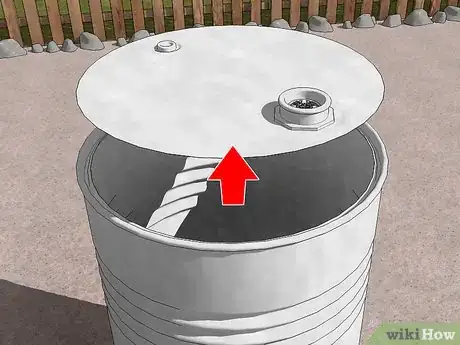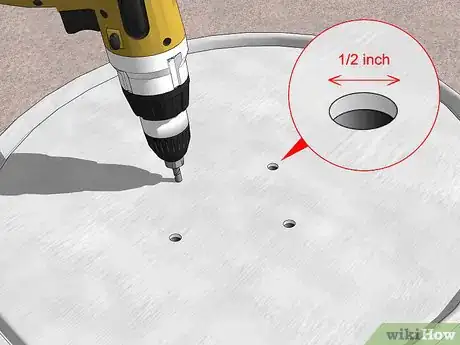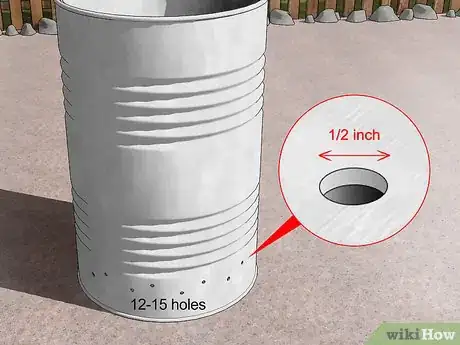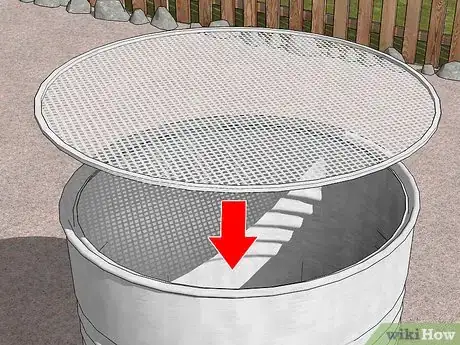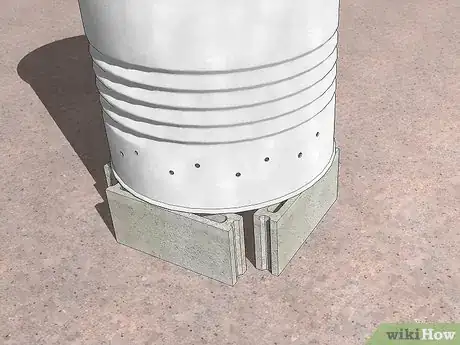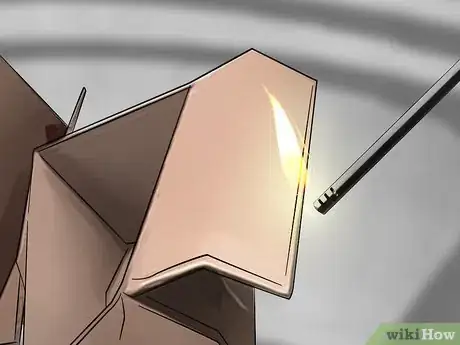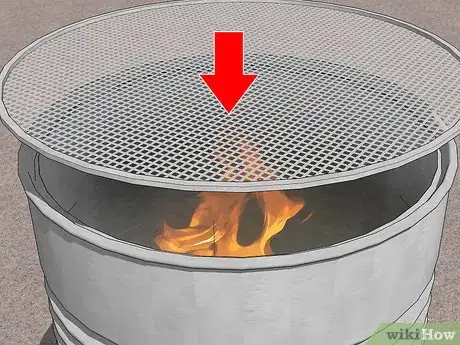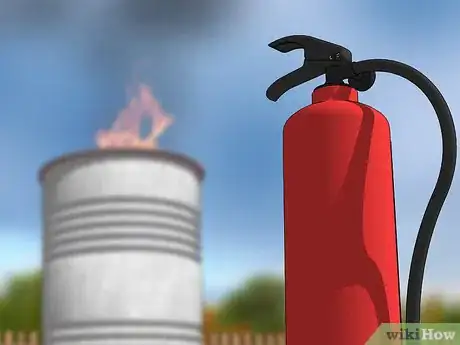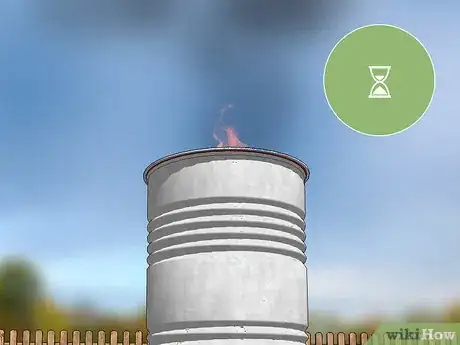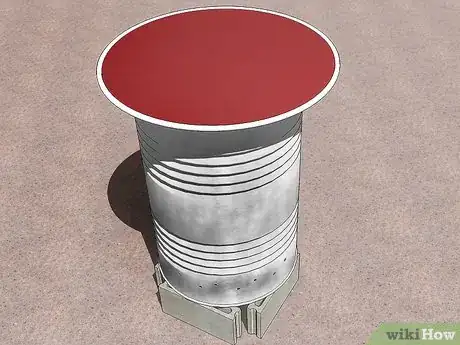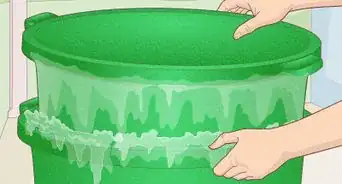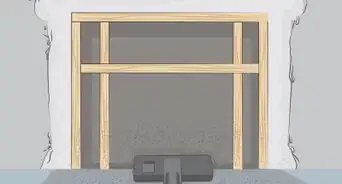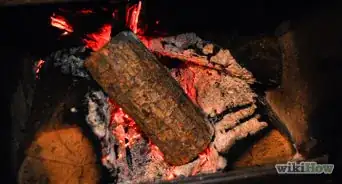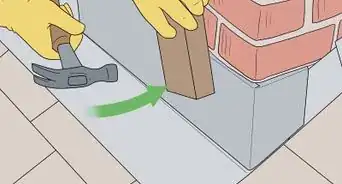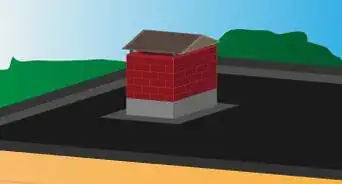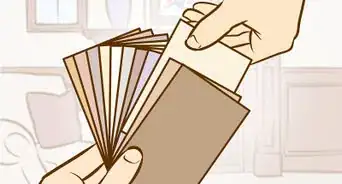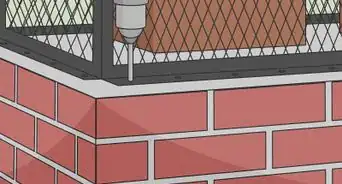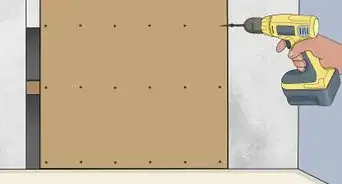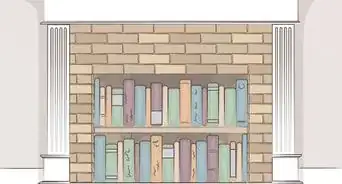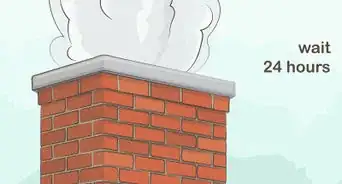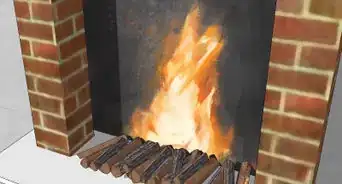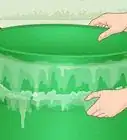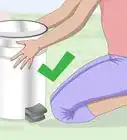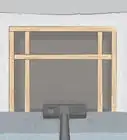This article was co-authored by wikiHow Staff. Our trained team of editors and researchers validate articles for accuracy and comprehensiveness. wikiHow's Content Management Team carefully monitors the work from our editorial staff to ensure that each article is backed by trusted research and meets our high quality standards.
There are 9 references cited in this article, which can be found at the bottom of the page.
wikiHow marks an article as reader-approved once it receives enough positive feedback. In this case, 97% of readers who voted found the article helpful, earning it our reader-approved status.
This article has been viewed 436,780 times.
Learn more...
Burn barrels provide a convenient way to dispose of burnable trash if you don't have the space to build a larger bonfire. Making your own burn barrel is as simple as finding a 55 gallon (208.2 L) metal drum, removing the lid or opening one end, and punching holes near the bottom to provide ventilation. Be sure to only use your burn barrel on your own property to eliminate materials that can be burned safely, like tree limbs, brush, and other natural debris.
Steps
Fashioning the Barrel
-
1Acquire a 55 gallon (208.2 L) steel drum. You can often purchase these for a small price from manufacturing plants, scrap yards, and recycling facilities. In some cases, you might even be able to find them lying around for free.[1]
- If you're unable to track down a suitable drum, you also have the option of buying one online. However, they will be a little more expensive—you can expect to pay as much as $80-120 for a brand new steel drum.
- It's important that the drum you use be made from thick, heat-resistant steel. Other materials won't be able to withstand intense burning temperatures, and may produce toxic chemical fumes as they melt.
-
2Open one end of the drum. If your barrel has a removable cover, all you have to do is pull it off. If the drum is “tight” (meaning both ends are sealed), however, it will be necessary to cut off one of the ends. To do this, use a reciprocating saw or jigsaw to cut slowly around the raised lip at the top of the barrel until the circular face comes away in one piece.[2]
- Wear thick work gloves to protect your hands while operating the saw. If possible, pull on a pair of earmuffs, as well. It's going to get loud!
- You can also use a barrel opener tool to pry open tight drums. These basically work like giant can openers—clamp the head of the tool over the edge of the drum, then push down forcefully on the handle to slice into the metal surface, repositioning the tool every 3–4 inches (7.6–10.2 cm).[3]
Advertisement -
3Create 3-4 1⁄2 inch (1.3 cm) drainage holes in the bottom of the drum. Flip the drum over and use an electric drill or hammer and chisel to open up a few evenly-spaced holes near the center of the bottom surface. These holes will let out any water the barrel happens to collect during a heavy downpour.[4]
- If the drainage holes are smaller than 1⁄2 inch (1.3 cm) in diameter, standing water may not be able to escape at a fast enough rate, which could make burning difficult or impossible.
-
4Drill or punch 12-15 1⁄2 inch (1.3 cm) holes in the sides of the drum. Once you've put some holes in the bottom of the drum, do the same for the sides along the lower half. You can pretty much make these holes at random, but keep them roughly the same distance apart.[5]
- The holes in the lower part of the drum will act as ventilation flues to supply the fire with oxygen and keep it burning hotter longer.[6]
- Avoid making too many holes, or it could weaken the structure of the drum. Any more than 20-25 is excessive.
-
5Find a piece of metal grating to use as a screen. A sheet of expanded metal will work well, as will a section of chain link fencing or flexible hardware cloth. Make sure your screen is large enough to cover the entire opening of the drum. It will help keep sparks and cinders from escaping while burning.[7]
- There shouldn't be any need to modify the screen, as you can simply slide the whole sheet into place over the drum. If you like, however, you can use your jigsaw or a pair of wire cutters to trim the screen to the same shape as the opening.
- If you decide to cut your grating, make sure it's 2–3 inches (5.1–7.6 cm) wider than the drum opening so it will be able to rest on top easily.
-
6Situate the drum at least 30 feet (9.1 m) away from surrounding objects. Keeping your burn barrel at a safe distance from trees and thick brush, as well as structures like garages, sheds, and wooden decks and porches, will help minimize the risk of accidental fires.
- Additionally, make sure there are no flammable items within 10 feet (3.0 m) of the barrel while it's in use.
-
7Place your burn barrel on 4 concrete blocks. Lay the blocks out on the ground in a square shape. Then, hoist the barrel up onto the blocks so that its outer edges sit at the center of each block. Elevating the barrel will allow air to pass underneath, drawing more oxygen into the flues you drilled earlier.[8]
- It's important that you use 4 blocks rather than 2 in order to prevent the barrel from accidentally tipping over.
Using Your Burn Barrel Safely
-
1Load the barrel up to the halfway mark with burnable rubbish. Throw whatever you want to burn into the bottom of the barrel. Add the largest items first, followed by the smaller ones on top. Avoid overfilling the barrel, as this could cause burning debris to spill out on the ground in the surrounding area.[9]
- Only use your burn barrel to dispose of materials that are safe to burn, such as tree limbs, brush, cardboard, paper packaging, and natural fabrics.
- Never burn household trash, plastics, rubber, chemicals, or wood that's been painted or treated. When burned, these items give off harmful fumes that are bad for both you and the environment.[10]
-
2Use a long lighter or match to ignite the rubbish. Hold the flame against a piece of material at the top of the heap until it catches, then withdraw your hand quickly. If you're using a match, drop it into an open space and wait for the fire to spread. It make take a couple tries to successfully get it started.[11]
- If you're having trouble getting your rubbish to catch, pile some dry wood underneath and on top of the items to serve as kindling, then light the wood instead.
- Don't use gasoline, kerosene, lighter fluid, or any other accelerants in your burn barrel. While these substances can make it much easier to start a fire, they can also cause it to burn out of control.[12]
-
3Slide your makeshift screen over the opening of the barrel. Once you've got the fire going, position the grating over the barrel to keep the flames contained and control stray sparks and cinders. The interwoven metal will also prevent other objects from accidentally falling into the flames.[13]
- The grating will become extremely hot very quickly, so be careful not to handle it once you've got it in place.
-
4Keep a fire extinguisher or water source nearby in case of emergencies. An extendable garden hose connected to your home's water line will work best. However, you could also fill a large bucket with water and leave it stationed next to the barrel.[14]
- Never use your burn barrel without having some means of putting it out close at hand.
-
5Let the fire burn itself out or use water to extinguish it. The fire will die down on its own after a while. If you want to speed up the process, douse the flames with water, making sure to turn the ashes between applications. Double-check that every last cinder is out before you walk away from the burn site.[15]
- Using water to extinguish fires in your burn barrel is faster, but it may prevent you from using it again as soon if the contents inside are still wet.
-
6Cover the barrel with a piece of sheet metal when it's not in use. The sheet metal serves a dual purpose. It will help extinguish whatever cinders are remaining after the fire has burned out while also keeping rainwater, mold, or nesting critters from finding their way in.[16]
- If your drum came with a lid originally, all you'll need to do is put it back on to keep your burn barrel covered.
- You can collect all the sheet metal you need at your local scrap yard. Rummage around until you find a piece that's the right size and shape to fit over the opening of your burn barrel.
Community Q&A
Did you know you can get answers researched by wikiHow Staff?
Unlock staff-researched answers by supporting wikiHow
-
QuestionAre burn barrels illegal?
 wikiHow Staff EditorThis answer was written by one of our trained team of researchers who validated it for accuracy and comprehensiveness.
wikiHow Staff EditorThis answer was written by one of our trained team of researchers who validated it for accuracy and comprehensiveness.
Staff Answer wikiHow Staff EditorStaff AnswerBurn barrels themselves are not necessarily illegal, but in many areas it is illegal to burn most materials in them. This is because burn barrels produce lots of smoke, which can be toxic if you’re burning materials such as garbage or chemically treated wood. The only thing you can safely burn in a burn barrel is untreated vegetation (such as branches you’ve trimmed from your trees). Local ordinances may prevent you from using burn barrels at all, or there might be strict rules regarding what you can burn in them, how far you must place the barrel from neighboring homes, and so on.
wikiHow Staff EditorStaff AnswerBurn barrels themselves are not necessarily illegal, but in many areas it is illegal to burn most materials in them. This is because burn barrels produce lots of smoke, which can be toxic if you’re burning materials such as garbage or chemically treated wood. The only thing you can safely burn in a burn barrel is untreated vegetation (such as branches you’ve trimmed from your trees). Local ordinances may prevent you from using burn barrels at all, or there might be strict rules regarding what you can burn in them, how far you must place the barrel from neighboring homes, and so on. -
QuestionHow do you keep a burn barrel from rusting?
 wikiHow Staff EditorThis answer was written by one of our trained team of researchers who validated it for accuracy and comprehensiveness.
wikiHow Staff EditorThis answer was written by one of our trained team of researchers who validated it for accuracy and comprehensiveness.
Staff Answer wikiHow Staff EditorStaff AnswerSome homesteaders advise laying the barrel down on its side on top of some cinder blocks to keep rain from getting in. You can put a grate over the open end to keep animals out (and material you’re burning in). For additional protection from rain, attach a piece of sheet metal roofing material to the top side of the barrel.
wikiHow Staff EditorStaff AnswerSome homesteaders advise laying the barrel down on its side on top of some cinder blocks to keep rain from getting in. You can put a grate over the open end to keep animals out (and material you’re burning in). For additional protection from rain, attach a piece of sheet metal roofing material to the top side of the barrel. -
QuestionHow long does a burn barrel last?
 wikiHow Staff EditorThis answer was written by one of our trained team of researchers who validated it for accuracy and comprehensiveness.
wikiHow Staff EditorThis answer was written by one of our trained team of researchers who validated it for accuracy and comprehensiveness.
Staff Answer wikiHow Staff EditorStaff Answer
wikiHow Staff EditorStaff Answer
Warnings
- In many cities and towns, it's against the law to burn trash. Be sure to check with your local fire authorities to see if you're permitted to make use of a burn barrel where you live.⧼thumbs_response⧽
- While you should never burn household garbage in your burn barrel, aerosol cans in particular are extremely dangerous. Once they get hot enough, it's possible for these items to explode and send metal shards ricocheting around the inside of the barrel.⧼thumbs_response⧽
- Avoid using your burn barrel on windy days. Strong gusts could cause flames to spread out of control and lead to accidental wildfires.⧼thumbs_response⧽
- Don't touch the barrel itself while it's in use, as it will be very hot.⧼thumbs_response⧽
Things You'll Need
- 55 gallon (208.2 L) metal drum
- Reciprocating saw or jigsaw with metal cutting blade
- Barrel opener tool
- Electric drill or hammer and chisel
- Expanded metal sheeting, chain link fencing, or hardware cloth
- Sheet metal
- Concrete blocks
- Long lighter or matches
- Protective gloves
- Earmuffs
References
- ↑ https://www.farmandfleet.com/blog/make-burn-barrel/
- ↑ http://fivegallonideas.com/cutting-open-55-gallon-drum/
- ↑ https://www.youtube.com/watch?v=X1hghMykySQ&feature=youtu.be&t=85
- ↑ https://commonsensehome.com/how-to-make-a-burn-barrel/
- ↑ https://www.survivethewild.net/cheap-hi-temp-burn-barrel/
- ↑ https://commonsensehome.com/how-to-make-a-burn-barrel/
- ↑ https://commonsensehome.com/how-to-make-a-burn-barrel/
- ↑ https://www.survivethewild.net/cheap-hi-temp-burn-barrel/
- ↑ https://fire.ak.blm.gov/content/admin/awfcg/D.%20Brochures%20and%20Educational%20Materials/Using%20Burn%20Barrel%202008.pdf
- ↑ https://www.epa.gov/burnwise/best-wood-burning-practices#what
- ↑ https://www.farmandfleet.com/blog/make-burn-barrel/
- ↑ https://www.survivethewild.net/cheap-hi-temp-burn-barrel/
- ↑ https://www.farmandfleet.com/blog/make-burn-barrel/
- ↑ https://smokeybear.com/en/prevention-how-tos/backyard-debris-burning
- ↑ http://www.livingthecountrylife.com/homes-acreages/country-homes/burn-barrel-safety/
- ↑ https://commonsensehome.com/how-to-make-a-burn-barrel/
About This Article
To make a burn barrel, start by getting a 55-gallon steel drum and cutting off one of the ends if the drum doesn't come with a removable cover. Then, drill 3 or 4 1/2-inch drainage holes in the bottom of the drum so that water can drain out if it rains. Next, drill around 15 1/2-inch holes through the sides of the drum near the bottom, which will provide ventilation so the fire burns longer. Finally, cover the top of the drum with a piece of metal grating so sparks and cinders can't escape. To learn how to safely use your burn barrel, scroll down!

